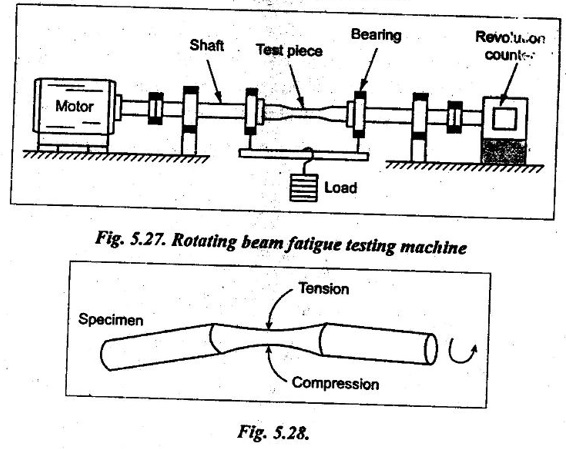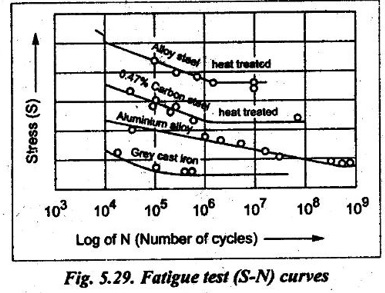Fatigue tests determine the resistance of material to repeated pulsating or fluctuating loads.
FATIGUE TESTS
✔ Fatigue tests determine the resistance of material to repeated pulsating or fluctuating loads.
✔ Fatigue defined: The capacity of material to withstand repeatedly applied stresses is known as fatigue.
✔The resistance of a material to fatigue failure is characterised by its fatigue or endurance limit.
✔ The endurance limit or endurance strength is defined as the maximum stress which a specimen can endure without failure when this stress is repeated for a specified number of cycles.
1. Arrangement
The schematic arrangement of the most commonly used rotating beam fatigue testing machine is shown in Fig.5.27.

2. Testing Procedure
The step by step procedure for fatigue testing is given below :
(i) The test specimen is placed on the machine.
(ii) Now the specimen is rotated using an electric motor.
(iii) When the specimen is rotating, it can be noted that the upper surface of the specimen is subjected to tension and its lower surface experiences compression, as shown in Fig.5.28.
(iv) As the specimen rotates, there is sinusoidal variation of stress between a state of maximum tensile stress and a state of maximum compressive stress.
(v) The cycles of stress are applied until the specimen fractures. A reduction counter records this number of stress cycles.
(vi) Now a number of specimen of the same material (at least six specimens) are tested in the same manner under different stress levels and the results are plotted on S-N graph.
(vii) The S-N graph is drawn on a semilogarithmic scale with the number of cycles (N) required to cause failure of the specimen on the X-axis and the stress (S) on the Y-axis. The resulting curve in a S-N graph is called as S-N curve.
(viii) The Fig.5.29 shows the S-N curves obtained on testing different materials.

3. Results of the Fatigue Test
✔ The fatigue test can tell us show long a part may survive or the maximum allowable loads that can be applied to prevent failure.
✔ The fatigue test is useful in setting the design criterion with the use of the endurance limit. Endurance limit is stress below which there is a 50% probability that failure by fatigue will never occur, which is the common design criterion.
✔ Fatigue life tells us how long a component survives at a particular stress. From the S-N curve, one can find the fatigue life (N) for the applied stress.
✔ Endurance ratio = Endurance limit / Tensile strength ≈ 0.5. The endurance or fatigue ratio allows us to estimate fatigue properties from the tensile test.
No comments:
Post a Comment